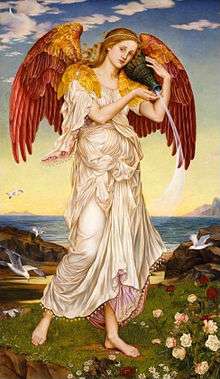Hausos

| Look up Reconstruction:Proto-Indo-European/h₂éwsōs in Wiktionary, the free dictionary. |
One of the most important goddesses of reconstructed Proto-Indo-European religion is the personification of dawn as a beautiful young woman.
Her name is reconstructed as Hausōs or Ausōs (PIE *h₂éwsōs, an s-stem), besides numerous epithets.
Etymology and cognates
The name *h₂éwsōs is derived from a root *h₂ews- "to shine", thus translating to "the shining one". Both the English word east and the Latin auster "south" are from a root cognate adjective *h₂ews-t(e)ro-. Also cognate is aurum "gold", from *h₂ews-o-m. The dawn goddess was also the goddess of spring, involved in the mythology of the Indo-European new year, where the dawn goddess is liberated from imprisonment by a god (reflected in the Rigveda as Indra, in Greek mythology as Dionysus and Cronus).
Derivatives of *h₂éwsōs in the historical mythologies of Indo-European peoples include Indian Uṣas, Greek Ἠώς (Ēōs), Latin Aurōra, and Baltic Aušra ("dawn", c.f. Lithuanian Aušrinė). Germanic *Austrǭ is from an extended stem *h₂ews-t(e)ro-.[1]
The Italic goddess Mater Matuta "Mother Morning" has been connected to Aurora by Roman authors (Lucretius, Priscianus). Her festival, the Matralia, fell on 11 June, beginning at dawn.[2]
Functions
Besides the name most amenable to reconstruction, *h₂éwsōs, a number of epithets of the dawn goddess may be reconstructed with some certainty. Among these is *wénh₁os[3] (also an s-stem), whence Sanskrit vanas "loveliness; desire", used of Uṣas in the Rigveda, and the Latin name Venus and the Norse Vanir. The name indicates that the goddess was imagined as a beautiful nubile woman, who also had aspects of a love goddess.
The love goddess aspect was separated from the personification of dawn in a number of traditions, including Roman Venus vs. Aurora, and Greek Aphrodite vs. Eos. The name of Aphrodite Άφροδίτη may still preserve her role as a dawn goddess, etymologized as "she who shines from the foam [ocean]" (from aphros "foam" and deato "to shine").[4] J.P. Mallory and Douglas Q. Adams (1997)[5] have also proposed an etymology based on the connection with the Indo-European dawn goddess, from *h₂ebʰor- "very" and *dʰey- "to shine". Other epithets include Ἠριγόνη Erigone "early-born" in Greek.
Myths
The abduction and imprisonment of the dawn goddess, and her liberation by a heroic god slaying the dragon who imprisons her, is a central myth of Indo-European religion, reflected in numerous traditions. Most notably, it is the central myth of the Rigveda, a collection of hymns surrounding the Soma rituals dedicated to Indra in the new year celebrations of the early Indo-Aryans.[6]
See also
Notes
- ↑ Mallory (1997:148—149).
- ↑ West (2007:226).
- ↑ De Vaan 2008
- ↑ Janda (2010), p. 65
- ↑ Mallory, J.P. and D.Q. Adams. Encyclopedia of Indo-European Culture. London: Fitzroy Dearborn Publishing, 1997.
- ↑ The view of Ushas and the surrounding Rigvedic ritual as a New Year celebration was first suggested by Hillebrandt in the 1920s. The proposal was at the time rejected by critics, but has since become the mainstream view, following a learned defense by Kuiper (1960). See West (2007), p. 225.
References
- Janda, Michael, Die Musik nach dem Chaos, Innsbruck 2010,
- Mallory, J. P. (editor). Adams, Douglas Q. (editor). (1997). Encyclopedia of Indo-European Culture. Taylor & Francis. ISBN 1-884964-98-2
- Martin Litchfield West, Indo-European Poetry and Myth, Oxford University Press, 2007, ISBN 978-0-19-928075-9.